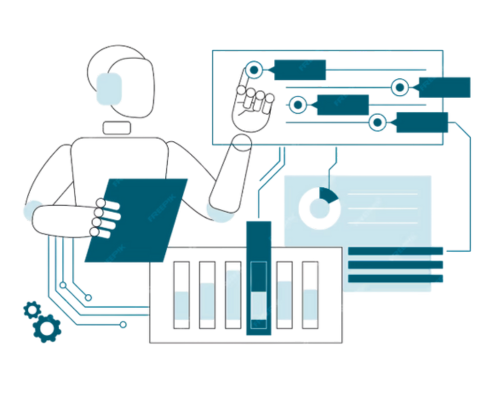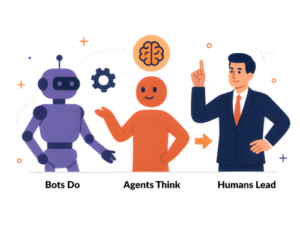The Day Automation Met AI Agents
It was a Thursday morning.
Anita, the operations manager at a leading insurance company, was reviewing her team’s performance dashboard over a cup of coffee when she noticed something. Some claims remained pending after the bot flagged for manual intervention.
Her team had implemented Robotic Process Automation (RPA) two years ago, and it had significantly improved process efficiency. Tasks that once consumed hours—data entry, form validations, report generation—were now executed within minutes, and with unmatched accuracy. Employees were no longer bogged down by repetitive work. Customer response times had improved.
The flagged claims highlighted an opportunity for much more sophisticated automation.
Anita found herself wondering.
“We’ve built a rock-solid foundation with RPA. But what if we could give our digital workforce more autonomy? Something—or someone—to handle the judgment calls too?”
To expand the capabilities of RPA, handling more, adapting faster, and elevating outcomes.
That’s when she began thinking beyond task automation. The future was about pairing RPA with new digital teammates—AI agents that could think, reason, and guide.
It was the day when RPA met AI Agents.
And so began their journey into Agentic Process Automation.
Understanding RPA and AI Agents
Let’s rewind for a moment. RPA (Robotic Process Automation) is a software robot that mimics human actions like clicking, typing, and navigating systems to automate rule-based processes. It’s fast, reliable, and has delivered measurable ROI across industries.
But RPA cannot make decisions beyond the rule-based script provided to it. It thrives in structured, predictable environments.
AI Agents, on the other hand, are autonomous, adaptive systems capable of perceiving context, making decisions, and learning from outcomes.
Where RPA handles the doing, AI agents enhance the doing with contextual thinking.
So, when these two technologies come together, agentic enhances the capabilities of RPA, birthing the new chapter in automation: agentic process automation.
Augmenting RPA with Agentic Intelligence
Back at the insurance firm, Anita decided to introduce an AI agent alongside the bots.
Now, when a claim came in with smudged handwriting, the agent:
- Interpreted the image using computer vision.
- Matched it with policyholder history using machine learning.
- Made a decision: Accept the claim, reject it, or ask for clarification.
- Triggered an RPA bot to execute the decision in the backend systems.
The result?
- Fewer exceptions.
- Faster resolution time.
- Happier customers—and even more productive bots.
This wasn’t just automation. It was intelligent orchestration.
How Agentic Process Automation Works
Let’s break it down.
RPA:
- Predefined workflows
- Works on structured data
- Rule-based logic
- Executes with precision and consistency
AI Agents:
- Goal-driven systems that adapt based on context
- Handle unstructured data (PDFs, emails, images)
- Make autonomous decisions
- Learn and improve with feedback
Together:
- RPA bots are the hands.
- AI agents are the brain.
Agentic Process Automation is not about replacing RPA—it’s about complementing and extending its reach into more complex, decision-heavy workflows.
Some Real-World Scenarios
Process Examples | RPA | APA |
Accounts Payable Automation | In retail, RPA extracts invoice data from PDFs, matches them with purchase orders in the ERP, and processes payments. If there’s a mismatch—say the PO number is missing—the bot alerts finance team and a finance team member step in to resolve it manually. | An AI agent monitors incoming invoices and not only extracts the data but also understands when critical fields are missing or misaligned. It cross-references supplier patterns, learns from past exceptions, and intelligently infers the correct PO number or flags truly anomalous ones for further review—while triggering the RPA bot to complete the rest of the payment process. |
Insurance Claim Processing | In health insurance, RPA bots collect claim forms, extract relevant data, and input it into the claims system. However, if medical records are scanned, handwritten, or contain unusual formats, the bot routes the case to a human for further review. | An AI agent handles the unstructured data—scanned handwritten doctor notes, medical terms, or new formats—and uses OCR combined with contextual learning to understand what’s being claimed. It makes an informed decision or recommendation and only sends edge cases to human experts. The RPA bot then executes the final claim settlement or communication. |
Customer Onboarding in Banking | For every new customer, an RPA bot performs KYC checks, sends welcome emails, and sets up accounts based on a predefined checklist. If a required document is blurry or expired, a representative is required to intervene. | An AI agent reviews the documents and uses image recognition to validate clarity and expiration status. If blurry, it requests a resubmission in a conversational tone via email or chat. It can also tailor onboarding steps based on customer type before triggering RPA bots to complete the setup. |
Avoiding the Trap of Agent Washing
Let’s be clear: Not every smart tool is an agent.
Many tools today use fancy language models or decision trees and are marketed as “agents.” But without autonomy, goal orientation, and adaptability, they’re not real AI agents.
According to Gartner, over 40% of agentic AI projects will fail by 2027 due to such over-promising and under-delivering—what the industry calls Agent Washing.
Final Thoughts
Back in her office, Anita looked out the window, reflecting on how far their automation journey had come. The introduction of AI agents unlocked new possibilities.
Now, her digital workforce didn’t just execute. It understood. It adapted. It collaborated.
Her team was building smarter workflows, designing intelligent systems, and finding new ways to create value across business.
The bots continued to deliver speed and consistency. The agents brought reasoning and adaptability.
Together, they formed an ecosystem that was agile, scalable, and future-ready.
And that’s what happens when RPA meets AI agents.
The future of automation is not either/or. It’s together.
Ready to Augment Your Automation?
We help businesses enhance their RPA capabilities with AI.
👇 Book a free consultation




